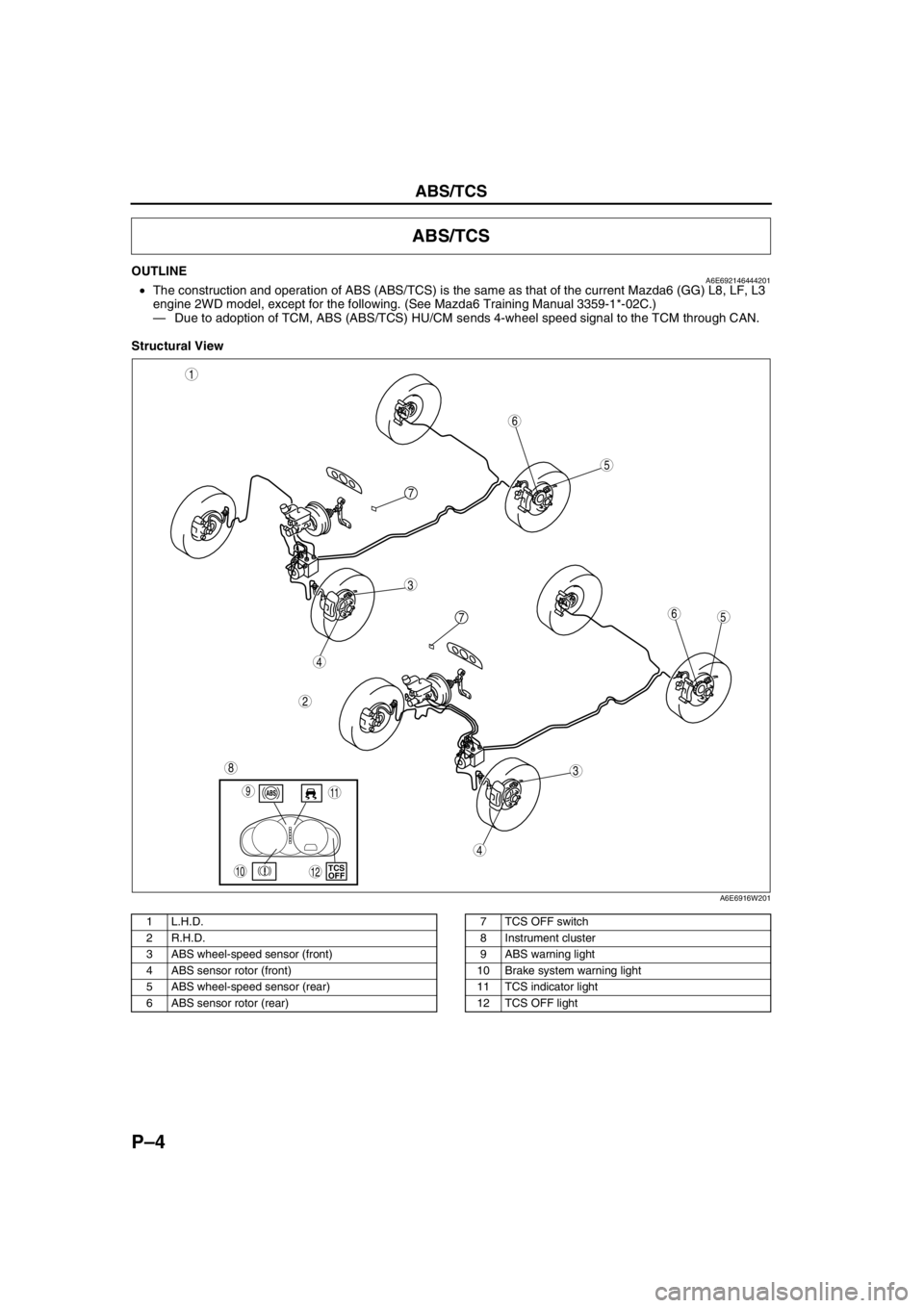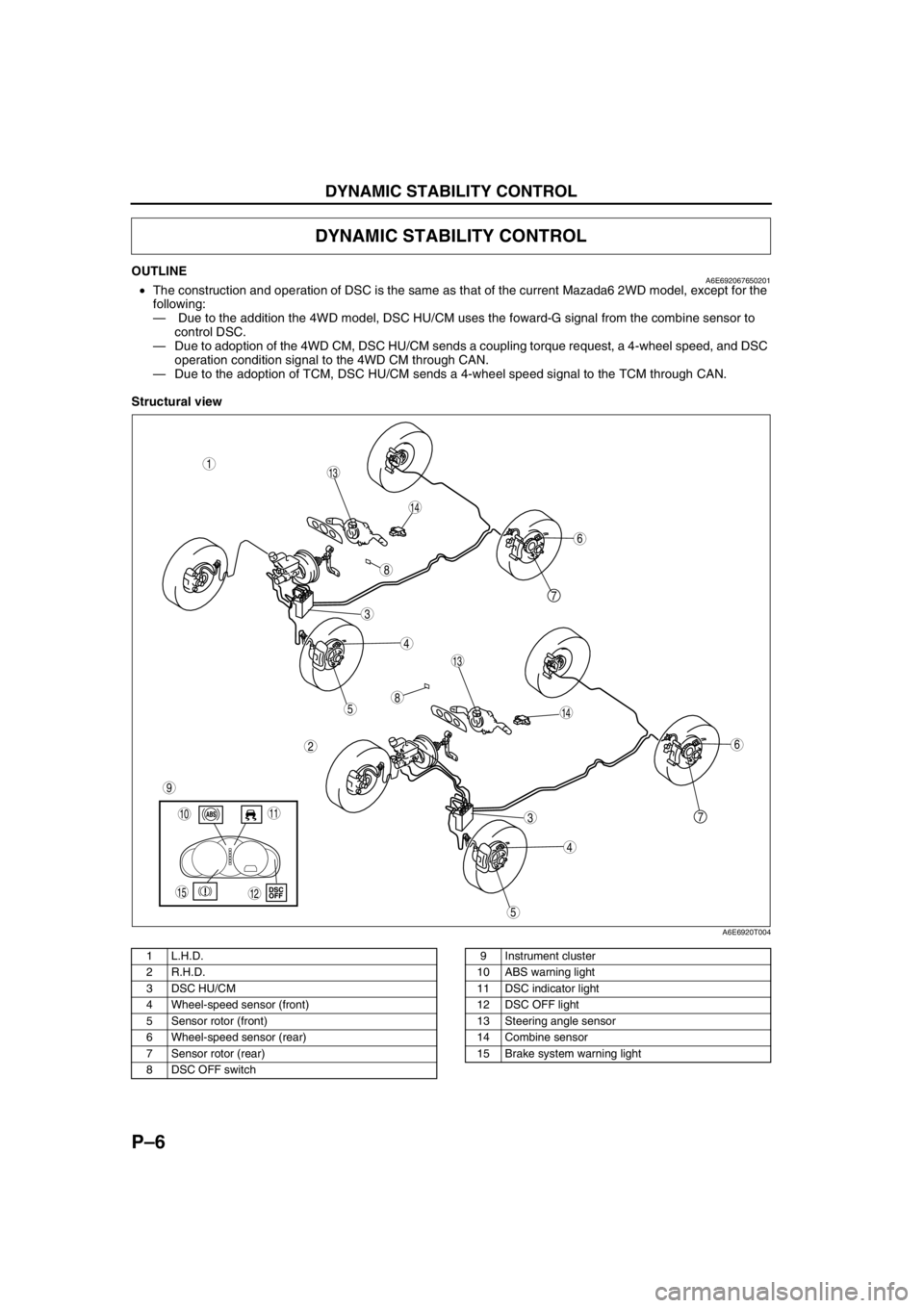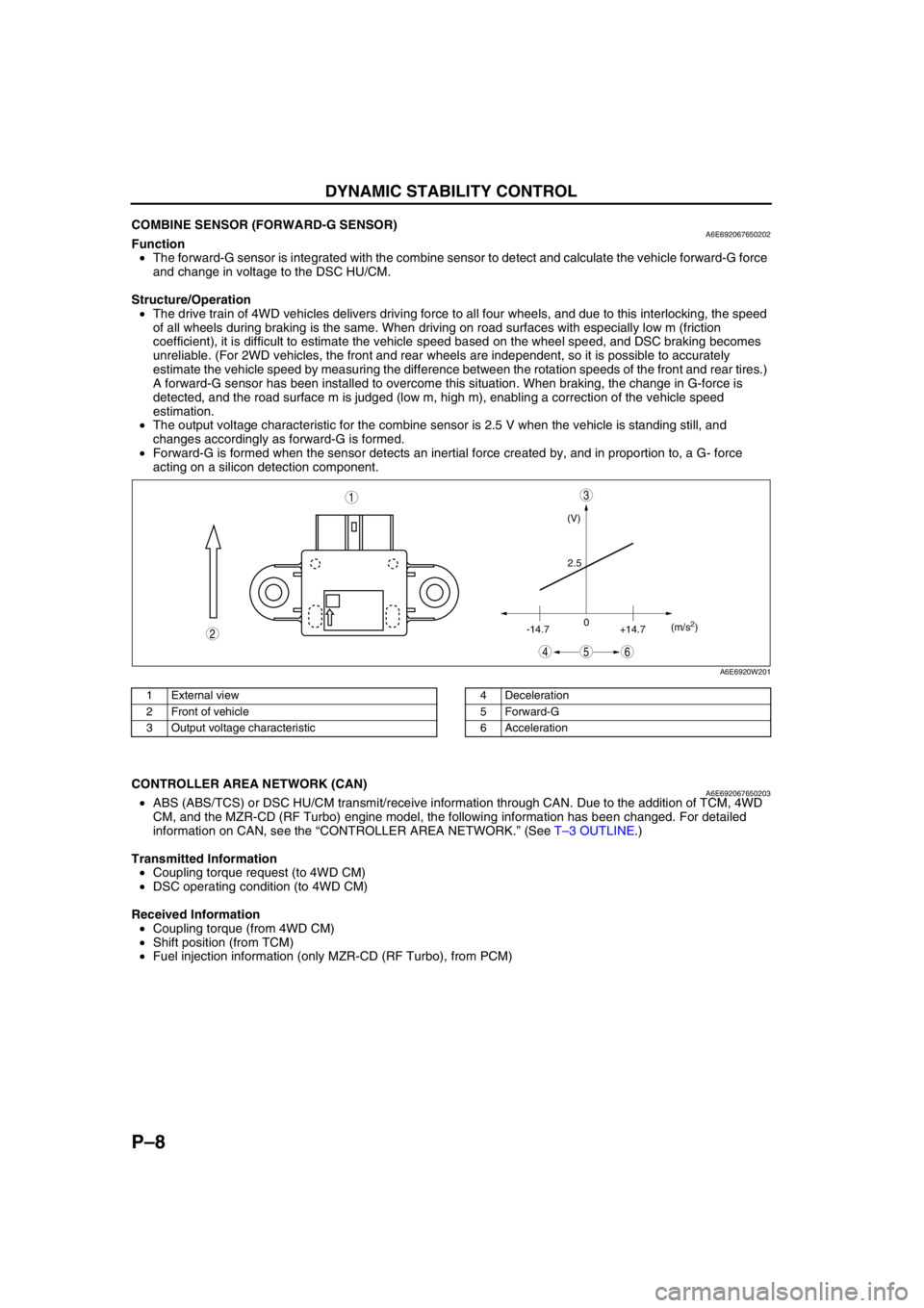sensor MAZDA 6 2002 Workshop Manual Suplement
[x] Cancel search | Manufacturer: MAZDA, Model Year: 2002, Model line: 6, Model: MAZDA 6 2002Pages: 909, PDF Size: 17.16 MB
Page 727 of 909

ENGINE SPEED SENSING POWER STEERING
N–13
N
STEERING GEAR AND LINKAGE (4WD) REMOVAL/INSTALLATIONA6E661432960202
Caution
•Performing the following procedures without first removing the ABS wheel-speed sensor may
possibly cause an open circuit in the harness if it is pulled by mistake. Before performing the
following procedures, remove the ABS wheel-speed sensor (axle side) and fix it to an appropriate
place where the sensor will not be pulled by mistake while servicing the vehicle.
1. Remove the under cover and mud guard. (Left side)
2. Remove the front auto leveling sensor.
3. Separate the stabilizer control link. (shock absorber side)
4. Separate the front lower arm (front and rear) ball joint.
5. Remove the shock absorber bolt. (lower side)
6. Remove in the order indicated in the table.
7. Install in the reverse order of removal.
8. Inspect the toe-in.
9. Adjust the headlight zeroset.
Page 734 of 909

P–1
P
PBRAKING SYSTEM
OUTLINE................................................................ P-2
OUTLINE OF CONSTRUCTION.......................... P-2
FEATURES .......................................................... P-2
SPECIFICATIONS ............................................... P-2
STRUCTURAL VIEW ........................................... P-3
ABS/TCS................................................................ P-4
OUTLINE.............................................................. P-4
DYNAMIC STABILITY CONTROL......................... P-6
OUTLINE.............................................................. P-6
COMBINE SENSOR
(FORWARD-G SENSOR) ................................. P-8
CONTROLLER AREA NETWORK (CAN) ........... P-8
ON-BOARD DIAGNOSTIC..................................... P-9
OUTLINE.............................................................. P-9
OUTLINE.............................................................. P-10
SUPPLEMENTAL SERVICE INFORMATION ... P-10
GENERAL PROCEDURES.................................. P-10
PRECAUTION (BRAKES).................................. P-10
CONVENTIONAL BRAKE SYSTEM.................... P-11
POWER BRAKE UNIT
REMOVAL/INSTALLATION ............................ P-11
VACUUM SWITCH INSPECTION
(MZR-CD (RF TURBO)) .................................. P-11
VACUUM SWITCH
REMOVAL/INSTALLATION
(MZR-CD (RF TURBO)) .................................. P-12
VACUUM PUMP INSPECTION
(MZR-CD (RF TURBO)) .................................. P-12
VACUUM PUMP REMOVAL/INSTALLATION
(MZR-CD (RF TURBO)) .................................. P-13
FRONT BRAKE (DISC) INSPECTION............... P-13
FRONT BRAKE (DISC)
REMOVAL/INSTALLATION ............................ P-14
DISC PAD (FRONT) REPLACEMENT .............. P-16
PARKING BRAKE SYSTEM................................ P-17
PARKING BRAKE (LEVER TYPE)
ADJUSTMENT ................................................ P-17
DYNAMIC STABILITY CONTROL....................... P-17
DSC HU/CM INSPECTION ................................ P-17
COMBINE SENSOR
(FORWARD-G SENSOR) INSPECTION ........ P-20
ON-BOARD DIAGNOSTIC................................... P-21
DSC ON-BOARD DIAGNOSIS .......................... P-21
DTC C1119 ........................................................ P-26
DTC C1949, C1950............................................ P-27
DTC U2511 ........................................................ P-29 FEATURES
SERVICE
Page 735 of 909

P–2
OUTLINE
OUTLINE OF CONSTRUCTIONA6E690201020201•The construction and operation of the braking system is the same as that of the current Mazda6 (GG) L8, LF,
L3 engine 2WD model, except for the following features. (See Mazda6 Training Manual 3359-1*-02C.)
End Of Sie
FEATURESA6E690201020202Modifications to match vehicle characteristics
•Due to the addition of the MZR-CD (RF Turbo) engine, the vacuum pump and vacuum switch have been
added.
•Due to the addition of the 4WD model, DSC HU/CM uses the forward-G signal from combine sensor to control
DSC.
End Of Sie
SPECIFICATIONSA6E690201020203
Bold frames: New specifications
End Of Sie
OUTLINE
ItemSpecification
New Mazda6 (GG, GW) Current Mazda6 (GG)
Brake pedalType Suspended
Pedal lever ratio 2.7
Max. stroke (mm {in}) 128.5 {5.06}
Master
cylinderType Tandem (with level sensor)
Cylinder diameter (mm {in}) 20.64 {0.813}
Front disc
brakeType Ventilated disc
Cylinder bore (mm {in}) 57.15 {2.250}
Pad dimensions (area × thickness) L8, LF (GCC specs.):
4,220 {6.75} × 10.0 {0.39}
LF (European (L.H.D. U.K.)
specs.), L3, MZR-CD (RF Turbo):
4,010 {6.42} × 12.0 {0.47}L8, LF (GCC specs.):
4,220 {6.75} × 10.0 {0.39}
LF (European (L.H.D. U.K.) specs.),
L3: 4,010 {6.42} × 12.0 {0.47} (mm
2 {in2} × mm {in})
Disc plate dimensions
(outer diameter × thickness)L8, LF (GCC specs.):
274 {10.8} × 24.0 {0.945}
LF (European (L.H.D. U.K.)
specs.), L3, MZR-CD (RF Turbo):
283 {11.1} × 25.0 {0.984}L8, LF (GCC specs.):
274 {10.8} × 24.0 {0.945}
LF (European (L.H.D. U.K.) specs.),
L3: 283 {11.1} × 25.0 {0.984} (mm {in} × mm {in})
Rear brake
(disc)Type Solid disc
Cylinder bore (mm {in}) 34.93 {1.375}
Pad dimensions (area × thickness)
2,810 {4.51} × 8.0 {0.31}
(mm
2 {in2} × mm {in})
Disc plate dimensions
(outer diameter × thickness)
280 {11.0} × 10.0 {0.39}
(mm {in})
Power brake
unitType Vacuum multiplier, single diaphragm
Diameter (mm {in}) 279 {10.9}
Braking force
control deviceTypeWith ABS: EBD (Electronic Brakeforce Distribution)
Without ABS: Dual proportioning valve
Parking brakeType Mechanical two-rear-wheel control
Operation system Center lever type
Brake fluid TypeEuropean (L.H.D. U.K.) specs.: SAE J1703, FMVSS116 DOT3 OR DOT4
GCC specs.: SAE J1703, FMVSS116 DOT3
Page 736 of 909

OUTLINE
P–3
P
STRUCTURAL VIEWA6E690201020204
.
End Of Sie
7
53
1
2
6
7
53
6
89
4
4
8
10
15
14
15
14
12
13
13
12
11
11
16
16
A6E6902W201
1L.H.D.
2 R.H.D.
3 Brake pedal
4 Master cylinder
5 Power brake unit
6 Front brake (disc)
7 Rear brake (disc)
8 Vacuum pump9 Without ABS
10 Dual proportioning valve
11 ABS (ABS/TCS) or DSC HU/CM
12 ABS wheel-speed sensor (front)
13 ABS sensor rotor (front)
14 ABS wheel-speed sensor (rear)
15 ABS sensor rotor (rear)
16 Combine sensor
Page 737 of 909

P–4
ABS/TCS
OUTLINEA6E692146444201•The construction and operation of ABS (ABS/TCS) is the same as that of the current Mazda6 (GG) L8, LF, L3
engine 2WD model, except for the following. (See Mazda6 Training Manual 3359-1*-02C.)
—Due to adoption of TCM, ABS (ABS/TCS) HU/CM sends 4-wheel speed signal to the TCM through CAN.
Structural View
.
ABS/TCS
5
3
1
2
6
7
5
3
6
8
4
4
7
9
10TCS
OFF
11
12
A6E6916W201
1 L.H.D.
2 R.H.D.
3 ABS wheel-speed sensor (front)
4 ABS sensor rotor (front)
5 ABS wheel-speed sensor (rear)
6 ABS sensor rotor (rear)7 TCS OFF switch
8 Instrument cluster
9 ABS warning light
10 Brake system warning light
11 TCS indicator light
12 TCS OFF light
Page 738 of 909

ABS/TCS
P–5
P
System Diagram
.
End Of Sie
9
9
8
7
5
43
12
6
18
17
15
16
14
13
11
12
RF
FL
RR
RL
PCMG
E
FI Z
U
D
A
B
C
Y
AC
X
V O
R ADAB AA
ABS/TCS HU/CM
pP
9
10
19
920
A6E6921W201
1 IG switch
2SUS 15 A fuse
3 ABS 60 A fuse
4 Meter
5 ABS warning light
6 Brake system warning light
7 TCS OFF light
8 TCS indicator light
9CAN driver
10 Brake light11 Cruise actuator
12 TCS OFF switch
13 DLC-2
14 CAN-H
15 CAN-L
16 ABS Wheel-speed sensor
17 Battery
18 Brake switch
19 Audio unit, Wiper and washer switch, Car-navigation
unit, Auto leveling control unit
20 TCM, 4WD CM
Page 739 of 909

P–6
DYNAMIC STABILITY CONTROL
OUTLINEA6E692067650201•The construction and operation of DSC is the same as that of the current Mazada6 2WD model, except for the
following:
— Due to the addition the 4WD model, DSC HU/CM uses the foward-G signal from the combine sensor to
control DSC.
—Due to adoption of the 4WD CM, DSC HU/CM sends a coupling torque request, a 4-wheel speed, and DSC
operation condition signal to the 4WD CM through CAN.
—Due to the adoption of TCM, DSC HU/CM sends a 4-wheel speed signal to the TCM through CAN.
Structural view
.
DYNAMIC STABILITY CONTROL
7
5
4
3
1
2
14
13
6
13
12
5
4
3
7
6
1011
9
14
8
8
15
A6E6920T004
1 L.H.D.
2 R.H.D.
3 DSC HU/CM
4 Wheel-speed sensor (front)
5 Sensor rotor (front)
6 Wheel-speed sensor (rear)
7 Sensor rotor (rear)
8 DSC OFF switch9 Instrument cluster
10 ABS warning light
11 DSC indicator light
12 DSC OFF light
13 Steering angle sensor
14 Combine sensor
15 Brake system warning light
Page 740 of 909

DYNAMIC STABILITY CONTROL
P–7
P
Wiring Diagram
.
9
RF
FL
RR
RL
PCM
G
E
M
I
F
K
H
Q
NJ
P
S
T
V
O
Y
X
W
U
R
L
Z
AC
D
B
AG
AF
AE
AC
AA
AB
C
F
D
A
B
EDSC HU/CM
A
B
C
D
F
1
3
2
8
7
5
4
6
9
9
9
10
11
13
12
15
14
18
17
16
1920
2122
24
23
A6E6921W203
1 IG switch
2SUS 15A fuse
3 ABS 60 A fuse
4 Meter
5 ABS warning light
6 Brake system warning light
7 DSC OFF light
8 DSC indicator light
9CAN driver
10 Battery
11 Cruise actuator
12 DSC OFF switch13 DLC-2
14 CAN-H
15 CAN-L
16 Wheel-speed sensor
17 Combine sensor
18 Steering angle sensor
19 Brake switch
20 Brake light
21 Back-up light switch (MTX only)
22 Back-up light (MTX only)
23 Audio unit, Wiper and washer switch, Car-navigation
unit, Auto leveling control unit
24 TCM, 4WD CM
Page 741 of 909

P–8
DYNAMIC STABILITY CONTROL
End Of SieCOMBINE SENSOR (FORWARD-G SENSOR)A6E692067650202Function
•The forward-G sensor is integrated with the combine sensor to detect and calculate the vehicle forward-G force
and change in voltage to the DSC HU/CM.
Structure/Operation
•The drive train of 4WD vehicles delivers driving force to all four wheels, and due to this interlocking, the speed
of all wheels during braking is the same. When driving on road surfaces with especially low m (friction
coefficient), it is difficult to estimate the vehicle speed based on the wheel speed, and DSC braking becomes
unreliable. (For 2WD vehicles, the front and rear wheels are independent, so it is possible to accurately
estimate the vehicle speed by measuring the difference between the rotation speeds of the front and rear tires.)
A forward-G sensor has been installed to overcome this situation. When braking, the change in G-force is
detected, and the road surface m is judged (low m, high m), enabling a correction of the vehicle speed
estimation.
•The output voltage characteristic for the combine sensor is 2.5 V when the vehicle is standing still, and
changes accordingly as forward-G is formed.
•Forward-G is formed when the sensor detects an inertial force created by, and in proportion to, a G- force
acting on a silicon detection component.
.
End Of Sie
CONTROLLER AREA NETWORK (CAN)A6E692067650203•ABS (ABS/TCS) or DSC HU/CM transmit/receive information through CAN. Due to the addition of TCM, 4WD
CM, and the MZR-CD (RF Turbo) engine model, the following information has been changed. For detailed
information on CAN, see the “CONTROLLER AREA NETWORK.” (See T–3 OUTLINE.)
Transmitted Information
•Coupling torque request (to 4WD CM)
•DSC operating condition (to 4WD CM)
Received Information
•Coupling torque (from 4WD CM)
•Shift position (from TCM)
•Fuel injection information (only MZR-CD (RF Turbo), from PCM)
End Of Sie
(V)
2.5
-14.70
+14.7(m/s
2)
45
3
6
2
1
A6E6920W201
1 External view
2 Front of vehicle
3 Output voltage characteristic4 Deceleration
5 Forward-G
6 Acceleration
Page 742 of 909

ON-BOARD DIAGNOSTIC
P–9
P
OUTLINEA6E697043000201•The operation of the on-board diagnostic system for ABS (ABS/TCS) or DSC is the same as that of the current
Mazda6 (GG) L8, LF, L3 engine 2WD model, except for the following. (See Mazda6 Training Manual
3359-1*-02C.)
— Due to the addition of the 4WD model, DTCs and PID data monitor has been added.
—Due to the addition of the MZR-CD (RF Turbo) engine model, the DTC C1119 fail-safe function and the
detection condition have been changed.
Fail-safe Function
Fail-safe function table
*1: When engine speed signal through CAN is out of specification, the light illuminates.*2: When engine speed signal through CAN is out of specification, the system is suspended.*3: When engine speed signal value through CAN is invalid, only brake TCS is available.*4: When fuel injection information through CAN is out of specification or invalid, only brake TCS is available.*5: When engine speed signal value through CAN is invalid, only brake DSC is available.*6: When the engine control system has a malfunction, only brake DSC is available.
PID/DATA Monitor Table
End Of Sie
ON-BOARD DIAGNOSTIC
Malfunc-
tion
locationDTC Fail-safe function
WDS
or
equiva-
lentWarning light illumination condition Control condition
ABS
warning
lightBRAKE
system
warning
light
(when
parking
brake is
released)DSC
(TCS)
OFF lightDSC
(TCS)
indicator
light ABS
controlEBD
controlTCS
controlDSC
controlBrake
assist
control
PCM and/
or engine
speed
signal lineC1119Not
Illuminated Not
Illuminated Not
Illuminated
*1Illuminated Available AvailableAvailable*2, *3, *4Available*2, *5, *6Available
Combine
sensor
(forward-
G) lineC1949
Illuminated Not
Illuminated Illuminated IlluminatedNot
availableAvailable—Not
availableNot
available
C1950
CAN line U2511Not
Illuminated Not
Illuminated Not
Illuminated Illuminated Available Available—Available Available
PID name input/output part Operation/unit
ACCLMTR Accelerometer ACCELERATION